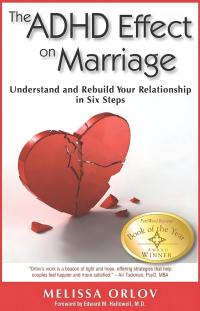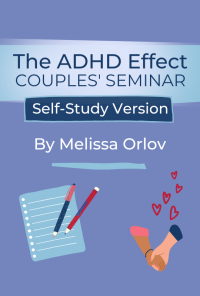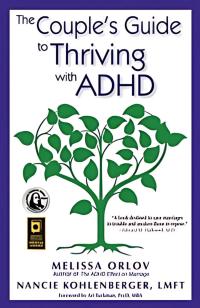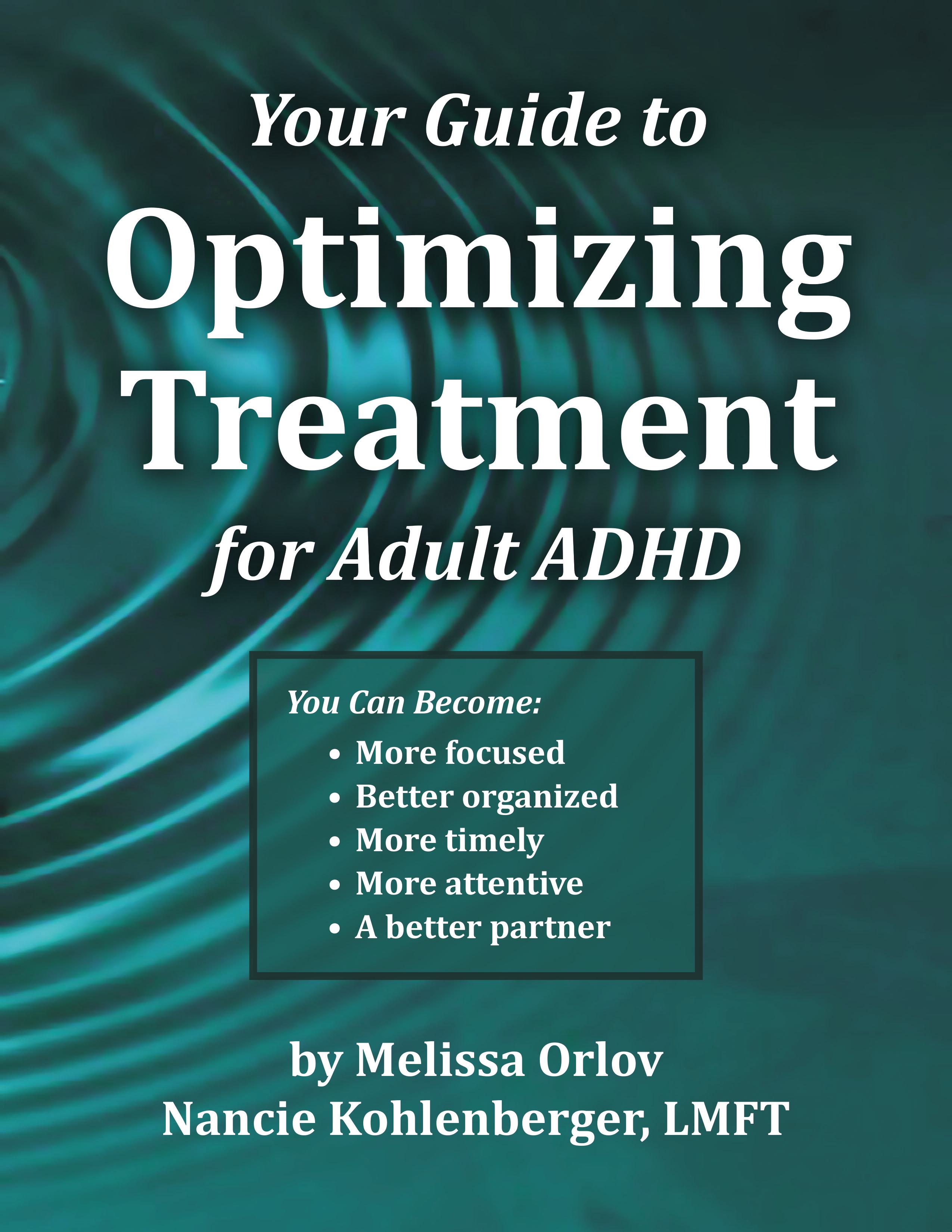It’s the catch-22 of ADHD-impacted relationships (and many non-ADHD marriages, as well!) For many couples impacted by ADHD, distraction, disengagement and retreat from conflict leave non-ADHD partners feeling ‘stranded’ and lonely. Their natural response is to pursue their partner for attention…and disaster results. What do you do?
As a non-ADHD partner I have often felt caught between a rock and a hard place, as the saying goes. I wanted to engage with my partner in happy, positive ways. But, particularly before we knew about the ADHD, his normal mode was often distracted and otherwise engaged. Being someone with a ‘can-do’ attitude (as many non-ADHD partners seem to be!) and not knowing about his ADHD, I just figured that if I ‘reminded’ him of his responsibilities (and that I longed for his attention), I would get his attention.
Instead, he took my reminders as criticism – a demonstration that I didn’t trust him to make good choices, and that I didn’t think he was a good partner. Over time, of course, as he felt more and more hounded and became more and more resistant to my overtures, he became right. I didn’t think he was being a good partner to me. I thought he could be a great partner, but that there was something getting in the way that I simply didn’t understand. As a result, I was criticizing him, even as I convinced myself that all I was trying to do was get things done.
If you find this downward “pursuit-retreat” spiral in your marriage, you need to seek immediate professional help with someone who can help you speak openly together about the interacting dynamics that are bringing you down. You need to explore your priorities, your friendship, and your communication style. A counselor who is familiar with ADHD will be best able to help you – there are some listed in my referrals section.
Expert marriage researcher, John Gottman, notes that the pursuit/retreat pattern (which he calls demand-withdraw) is a good predictor of divorce both early in a relationship and later on. In addition, he adds a word of warning that is worth sharing here – that dysfunctional interactive conflict resolution patterns such as demand-withdraw have their origins in everyday nonconflict interactions. He notes that both couples and their therapists make the mistake of assuming that improving the conflict communication patterns will ‘fix’ the problem, but that this is not the case.
Solving the problem of communication is helpful, but long-term relief from the problem comes from addressing the withdrawal (and the demanding) at their most basic levels, and creating ongoing connections that make both partners happy to engage together.
In other words, it is not enough to “fix” how you speak to each other or simply to be more friendly, though that will help. Couples must, at a very deep level, become friends again – accepting and appreciative of what each individual contributes to the couple and to life outside the framework of the relationship. They need to regularly see the positives in each other (at a ratio of about 5 positives to 1 negative, according to Gottman.) As ‘friends’ they should be eager to share with each other, and know the constantly changing details about each other and their individual lives.
And that, perhaps, is why getting out of pursuit-retreat patterns is so tricky. It’s too easy to focus on solving the problems of how you communicate…and too easy to forget about re-locating your underlying respect, friendship, and love for each other. To succeed, you must tackle what’s underneath as well as the most obvious issues.
- MelissaOrlov's blog
- Log in or register to post comments









Comments
Oiy!
Hi Melissa,
Nice to have you back!
As a spouse who was so wrapped up in this behavior, all I know at this point in time is that my pulling away, my not participating, has me feeling SO GUILTY. I am watching as my spouse spins deeper and deeper into his depressed state. It was quite a sick pattern we had going on for many years. Now I changed my pattern, and he seems to be left out in the cold.
Gotta say, from a women who really loves the man she married, yet also actually despises his behavior, this tough love position I have to take, is really truly close to unbearable.
I am taking the position that I gotta work on my stuff and he's gotta work on his stuff. Surely hard when my stuff was my stuff and his stuff was my stuff.
*******I have recently seen a lady looking back at me from the mirror - and I said, "Hello friend. Long time no see!""*******
I Really Love What You Said So Exhausted.....
and for the record. I've noticed a change in your posts since last spring when I first found this site. Taking a break from it for a few months makes it easy to see the difference...in case you were wondering?
sounds more like healthier inter- dependence instead of unhealthy co-dependence?
I'm not exactly sure (specifically) what you mean about the tough love thing (in relation to it's common usage referring to child rearing )...or maybe I'm being a little blind, duh?....after reading all these posts for so long it would be hard to deny my own ADHD patterns in them as being somewhat child like which I cannot argue yet..... I still will up to a point (lol)......since we (ADHD spouses) are NOT children unfortunately, we have a lot more experience and knowledge behind us to know when someone is trying to control us or be parenting....it doesn't work!
I need to read what Melissa said a few more times since there is some really good information in it for me as well as how she put this into her own real life situation as an example of things she went through...her thoughts and assumptions that played into her own situation ( from a woman's/spouse side ).
My own personal extrapolation from your "tough love" comment including the other things you said......and in reference to a couple things that Melissa just said about the pursue-retreat pattern is......
I hate confrontation and always have. I have lots of reason in thinking for this but the truth is that I avoided it no matter what even if the cost hurts me in the end....which it has in my past.
But I have learned how to be assertive much better in communicating my own needs to other people even in the face of someone who is be very confrontational or completely unreasonable at times ( not necessarily my wife ).
By doing this more often in recent times where before I would just retreat ( with attitude )....I now realize a big part of avoiding confrontation came from not being good at it in the first place which always left me conceding for the sake of argument many times (no win there).......or becoming angry and blowing up after avoiding it for so long I couldn't stand it any longer ( like an exploding boiler ). This is the long fuse I have referred to in myself which is nothing more than me hating and avoiding confrontation so much that I lose it because I'm forced to confront something when I absolutely do not want to. I think the emotional lability that Melissa talks about for ADHD'ers comes into play within this scenario for me........ but the emotion is fear (or the insecurity in the belief you are gong to lose) that drives the anger.
The retreat is conceding the loss ( sometimes before it ever happened ) and going off to finding a way to get my needs met else where. That is the feeling for me exactly. Avoiding confrontation, conceding defeat and moving away (or running away?) instead of actually fighting for what I believe in.....in my case, my relationship to my wife.
That's what I see you doing and I commend you for it. Your husband is lucky enough to have someone in his life that cares about him that much.
So back to the tough love thing.....for me this means (now) standing my ground and not conceding if I know that I am following the course that is in both mine and my wife's best interest, not letting things build up inside me to the point of blowing a gasket, and fighting for my relationship not with overt angry confrontation but with consistent confronting uncomfortable issues and not backing down when I know that I am right......right for me not for anyone else including my wife.
If I know in my heart of hearts that if I am acting in a way I would myself find acceptable, then standing my ground on this much might be my version of what you are talking about when you say say "tough love?"
It feels awkward ad uncomfortable still but the more I do it the better I become at it. The end result of doing this has shown some positive results but not necessarily in the moment. Standing your ground also requires some patience for it to work.
I'd be curious to know what you think about all of this?
For me, a lot of it has to do with learning from an early age that (I) always lose the fight when it comes to confronting others with issues ...and the fear of this interaction which always resulted with me losing in some way and the price was just always too high. That's pretty easy to grasp on a fundamental level. (especially when it involved something I wanted or needed from them)
J
Oiy Vey!
Well J, thank you for what you said.
LOl! Oiy Vey! The main thing I have been working on in myself is getting rid of the parent-child dynamic in my marriage. So inasmuch as 'tough-love' is a parenting style, my subconscious choice of that word is pretty funny, don'cha think?!?!?!
I am thinking of the alternative meaning aimed at adult situations, specifically knowing in my own heart that the full intent of my actions, those that my spouse and my daughter see as being harsh and mean, will lead to something better.
What you said: "the tough love thing.....for me this means (now) standing my ground and not conceding if I know that I am following the course that is in both mine and my wife's best interest, not letting things build up inside me to the point of blowing a gasket, and fighting for my relationship not with overt angry confrontation but with consistent confronting uncomfortable issues and not backing down when I know that I am right......right for me not for anyone else including my wife." Yes, that is it in a nutshell! I always bent and swayed and yielded to him. Even when I knew better.
I am hiring someone to put up 45-50 feet of fencing - beautiful vinyl fencing with lattice on top - stretching from the side of our barn north towards the woods. 5 eight foot sections with a man gate right at the barn. And no, dear spouse, you really do not have time to do it yourself, and yes indeed you would do a beautiful job, and no I do not want to make-do with someone else's cast offs to save money, and yes I really believe this is an investment into our marriage because this issue of yard clutter really needed to be addressed for my own piece of mind, because yes, I respect your stuff as your stuff, and I also respect my own need for a tidy yard.
Yet, do I think this approach is working? Well it has definitely improved my own state of mind. However, it has also driven my spouse to retreat to sleeping in our RV. For the past three months. To escape from me.
He is very depressed. I am hopeful that will be addressed, Last night he told me he was sick of feeling so hurt all the time. He also said the counselor he is working with has suggested he might try Wellbutrin. I hope he will decide to do it for himself. I believe with all I know that once he gets his head a bit clearer, he will see things in a different light. And if in the end, we worked our way right out of our marriage, I will be at peace knowing all the work was done, and it was a decision that was made in practicality, not in anger, or retreat. We both deserve to be happy. Even if we cannot find happiness together, we will always have the two beautiful children we created.
I think my heart has shifted. Thank you for noticing! Not all that long ago I thought the perfect solution would be to sit that man down, have an intervention, and tell him how his behavior has affected us all. I thank the good Lord that never was done. It really would have done him harm. Today I woke up thinking how nice it might be to ask our family to write him a note sharing something he did that really made them happy. You know, a happy or fond memory. He does need a nudge in the right direction.
*******I have recently seen a lady looking back at me from the mirror - and I said, "Hello friend. Long time no see!""*******
Sounds Like We are Thinking the Same Thing
I had to do something similar with my wife because I knew she was struggling with her own issues and was pulling me into it....(seeing me as the source) and blaming me for what was wrong with her. I could see this even if she couldn't. I had to stop stepping in to the pooh pile that was right in front of me even though she kept demanding that I do...(thinking that she needed me to) to make her "feel" better. When I told her I was no longer stepping into the pooh pile she pouted, got angry and then got depressed. ...
but after a while she began to come around and actually see the pooh pile too and even though her shoe's still had pooh on them (so she was used to pooh on her shoes already) she could see the value of me not doing it.
It was a process but it worked. It took repeated confrontations about the merits of not stepping in pooh but it finally clicked. If I had not done what I had done and stay the course this would not have happened. Lots of other topics got discussed besides pooh as well so the standing my ground when I knew it was right did work.....but was also exhausting!!! I really had to bite my tongue and not do what I would have done in the past by deafault......and that was to just get angry. I actually did lose it only once but even in losing it and yelling I was consistent as it was the same topic and it wasn't something displaced or new added in. It would have been better if I hadn't lost it at all and I'm still working on that much ( the wearing me down until I lose it ) but there was no question in this case that pooh is stinky and foil and no one should have to step in it.......but you're free to if you want, no one is stopping you just don't ask me to. I prefer a few extra steps around it if you don't mind. ha
I'd bet your daughter will notice ( after a while that each time you stand for the right decision ( as she can see it ) that you might come out looking even better not worse in eyes in the long run. Like I said, this a long term kind of approach, this really doesn't apply in cases ( like this forum ) where the crisis is whether you are leaving or staying....that's a different ball game than this.
Personal story: My father was always the king of the castle and my mom was pretty submissive and never made waves.....that is until she turned 50. Some wild hair got up her butt and she changed tunes rather dramatically. I still don't know exactly what happened but I now suspect that my father did something he shouldn't have and they just never told me. Wow, what a change that made. My mother became very assertive ( and she got the "look" ) and even was known to swear at times. You have to understand that my mother was the most God fearing Pious woman you could ever meet and never swore ever. She admitted only ever being drunk once in her life and that was enough to not drink from that day on, ever! She was a Saint I'm telling you.....so we all knew when she said the word "shit"....this woman meant it! It was time to run for the hill because the big dog had just come out to play.....including my dad. It was hilarious. I was in my late teens and was always looking for an excuse to get out of the house.
"Mom said the word "shit" again...gotta run!"
It only made me respect her more....as well as giving me another reason to smile. lol
J
Tough Love Approach Won't Work
It is very true that you will not thrive if you are co-dependent...but "Tough love" as an approach smacks of parenting, I think. You are setting the rules and he gets to live by them. That's not quite a partnership. Your partner is likely to feel diminished and unsupported. Rather than choosing "I take care of me" and "You take care of you" approaches, how about an approach which is "together, we each take care of our own issues as we move towards common goals." This stance suggests that you are supportive of each other's efforts while not interfering with the specific direction each person takes.
So, for example, you might both share the goal of enjoying each other's company more again. That means each of you needs to do some specific things - such as stop complaining, get more organized about creating dates, using positive and supportive words with each other (always good when you want to enjoy each other more). But the nature of the assignment suggests a linking together of purpose.
Work in parallel for a common goal.
The other thing that bothers me about tough love is that in that particular mode you will likely never hear what he is really thinking and feeling. This is tough for many men in any event. But if you are the "tough guy" what will encourage him to reflect and improve? Being scared of you, perhaps? That doesn't sound very much like a happy partnership.
Think about your boundaries - your own boundaries - and be the person you want to contribute to the relationship and also be the person you, yourself love. And then encourage forward momentum by laying out the dreams you both have that you wish to work towards.
Hope that's not too confusing - it's a very fine line.
I will ponder that for a while
"Your partner is likely to feel diminished and unsupported." That is surely not a result I would want. My goal is not to turn the tables on him, as I feel diminished and unsupported. Yet another Catch-22?
"Work in parallel for a common goal." I do not know how to do that. Seriously. I follow, or it feels as if I am just left out in the cold. How do I find a common goal?
It surely has to be a tough love approach to the degree that I will love him, and try to understand him, and live with behavior that does not feel too nice. What else could I call living in the same space with a prickly porcupine who believes he is a soft snuggly bunny and just cannot understand why I won't hug him?
If the terminology is incorrect, perhaps it is "detaching with love?"
*******I have recently seen a lady looking back at me from the mirror - and I said, "Hello friend. Long time no see!""*******
Detaching with Love
Detaching with love might be better...
The living with behavior that doesn't feel too nice, though, concerns me. Underneath that mistreatment there lies a kernel of truth that needs ferreting out. For example, your husband might be saying mean things to you because he feels diminished by you and that makes him angry, so "mean" is the only way he can respond. The mean things are the symptom of something much deeper. Until you both identify those deeper issues (i.e. feeling diminished in this example), your relationship will remain stuck, and BOTH of you will become more and more ambivalent about each other. This is not a good place to get to...living with "sort of good enough" does not make a happy partnership.
As for finding a common goal, do you ever talk with each other about your dreams? Where you might be in the future? Or perhaps you might talk about what you love doing right now? If you share dreams, then perhaps that will help you find a common place to move forward to...which is so much more motivating than rehashing the past and current grievances. If you can't articulate your own dreams (or if he can't articulate his) then it's probably time to start working with a therapist or counselor. There are some on my referrals page, including a few who might work by phone.
You Nailed It
Hi Melissa,
You wrote,
"The living with behavior that doesn't feel too nice, though, concerns me. Underneath that mistreatment there lies a kernel of truth that needs ferreting out. For example, your husband might be saying mean things to you because he feels diminished by you and that makes him angry, so "mean" is the only way he can respond. The mean things are the symptom of something much deeper. Until you both identify those deeper issues (i.e. feeling diminished in this example), your relationship will remain stuck, and BOTH of you will become more and more ambivalent about each other. This is not a good place to get to...living with "sort of good enough" does not make a happy partnership."
and..........
"The other thing that bothers me about tough love is that in that particular mode you will likely never hear what he is really thinking and feeling. This is tough for many men in any event. But if you are the "tough guy" what will encourage him to reflect and improve? Being scared of you, perhaps? That doesn't sound very much like a happy partnership."
and...
"It is very true that you will not thrive if you are co-dependent...but "Tough love" as an approach smacks of parenting, I think. You are setting the rules and he gets to live by them. That's not quite a partnership. Your partner is likely to feel diminished and unsupported. Rather than choosing "I take care of me" and "You take care of you" approaches, how about an approach which is "together, we each take care of our own issues as we move towards common goals." This stance suggests that you are supportive of each other's efforts while not interfering with the specific direction each person takes."
Wow.....this is so perfect. I put what you said in this order as it reads because it identifies and outlines how I see myself and my relationship with my wife to a T.........and perhaps an alternative to many of the things that have been mentioned in this blog by myself and so exhausted.
Honestly.....the only advantage that I have in my struggles with having ADHD and the problems that it creates in my relationship with my wife or anyone else for that matter is simply being aware of it ( the problems, it sources and what to do about it). But that hasn't given me any special ability to completely STOP the symptoms or make them go away entirely....
What is has done is make it possible to change. I no longer feel helpless or hopeless or the need to be a victim to it. This is huge!! I also can see the improvement in my self regardless if anyone else can and I do take ownership of it even though it is a work in progress and always will be. I also accept this as a permanent on going situation that I will always have to be conscious of it in order to continue to improve.
It's my burden no one elses......but at the same time, I need the ability to manage it and do what I know works and have my wife or other important people in my life be considerate of this fact.
What you said about feeling diminished and unsupported is so true........ It makes me feel like I am alone in stead of being with a partner.
What you said about the "tough love" being like "parenting" is also very true............I'm not a child with ADHD, I am an adult with it who is also aware of it and working on it.....willingly! This approach feels too much like coercion and punishment or at least like an ultimatum. It kills free will. motivation and any desire to do anything with or for the other person let alone be close and intimate with them. If anything....it does just the opposite.
And what you said about the "kernel of truth" that needs "ferreting out" and being "stuck" resonates with my own situation and so many references to it that I have made here in this forum I know I'm beginning to sound like a broken record......on top or a soap box on a street corner. lol
The gift that comes with being aware of myself is that I can also see many times when someone else isn't. I can choose what to do with this but in the case of my wife my first choice is to be supportive. But that does become the catch-22 on my end that so exhausted referred to in light of her own situation.
But that's the fine line you are talking about and the standing my ground I referred to here. What do you do? It doesn't feel co-dependent on my end ( simply because I'm not going there with her). That's one of the "pooh piles' that I was referring to.
This is the bottom line for me......I accept having ADHD and all the challenges that go with it but it is too much for me to work on the problems that it does pose for me If I have to also take on someone else's issues at the same time including the fact that they appear unaware of them or at the very least are not willing to do the work themselves ( the same as I have had to) to take responsibility and ownership of their part of the equation.
That's where it gets stuck.
How do you get someone else to see their part ( to be aware of their own personal issues, neurosis etc) , not taking responsibility for those parts that aren't yours.......... and keep on a steady course in working on my own ADHD at the same time?
Withdrawing and getting angry have been my default but this clearly is not a viable solution either.
I love what you wrote here and it really has helped give me some perspective. You summed up so much in a very short space.....being succinct is also not one of my virtues. lol
J
I really think I just used the wrong word
In my mind, I was attempting to communicate that I am setting strong personal boundaries, and will not crumple into a weeping mess when those boundaries are met with his anger. Thus my own boundaries are firm.
"Tough love" was surely a poor choice of words.
Liz
*******I have recently seen a lady looking back at me from the mirror - and I said, "Hello friend. Long time no see!""*******
What to do?
I think you either have to sit down in a different mode - something that helps your partner see that this is something different from the norm - and say something like "I think we have this incredibly serious problem that needs to be addressed, and I don't think we are doing the best job of it...we need help - probably professional help - to get at this important issue that feels like it's tearing us apart."
Best case scenario is your partner pays attention and opens up to the dialogue. Worse case is your partner doesn't listen...and then you are exactly where you have been.
Eureka! An Actual ADHD Breakthrough...sort of
Hi Melissa,
I should be putting this in the communication section but since it is in context to this thread I thought I would share it here.
I did want to mention first that my wife and I have seen counseling together and it has been helpful.
The cons to counseling from my experience is: getting both parties on the same page. That seems to be the trick I think. The hour goes by and before you know it......very little ground gets covered until next time. And when next time comes it's a different day and a different set of circumstances. Over time it works but in the mean time, you're still back together dealing with the same set of problems with a few new things to think about and try. Most of the time it feels like every new discovery (about the issue) opens up even more things to deal with or try and communicate with each other....and if communication is the issue ( getting on the same page) then it can become even more of a challenge instead of less.......sometimes.
So in light of what you said about sitting down in a different mode.......when both sets of ears are working.........I started to approach my wife directly about how we see things differently ( the same issue). As we started talking, I began to feel the familiar frustration setting in right away since we appeared to be talking about two different subjects....hence the frustration.
Once I realized that we were headed down a very familiar path I had an idea....I put her on hold for a moment and I went and got a pen and paper. I drew a bunch of circles and arrows....some overlapping and some not. It looked like a diagram out of a football play book. I sat it down in front of her and asked her to point to just what she was talking about. What I discovered from this was very enlightening.
She balked at first but I said to just indulge me....I'm ADHD and very visual so I used that as my reason for needing to do this which is very true. I do have trouble at times listening only and do much better with visual aids.....of any kind!
As we continued to talk....I kept referring back to the chart asking...."are we still here or are we here?" Pointing to the circles and arrows. After only a short time I realized what one of our major communication issues has been looking back over time and including that very moment.
My wife only saw one or two circles even though I had half a dozen drawn. And since she literally could not see ( or was thinking about the other circles ) and how they overlap with one another......everything that I was saying in reference to those was completely unheard and was a waste of my time and effort including making me frustrated and mad at the end because to this.
Everything in her field of view was contained only in the two circles....everything else was invisible to her. I have mentioned to her in passing many times that I always see the forest first and then the trees.....and she always see's the trees first and sometimes never noticing the forest.
I told her right then that hypothetically, if we had pulled the car over and stopped at a scenic view point and stood side by side outside of the car she would probably say something like, " look at the bark on that tree....and how the moss grows all around the base...isn't that interesting?"
I would in the the same moment say something like " look at how that river runs from that lake all the way over to the base of those mountains and how the forest comes right up to the lake but stops right at the mountains.........." and then say " what bark, where?"
I realized that this is what our conversations are like. She sees things through a micro-scope in a very limited field of view.....I on the other hand see things through a telescopic/wide angle lens that needs to be adjusted way down and refocused in order to see things very close in front of me. Both have their strengths and weaknesses but....if you want to talk about the view it's really hard to share thoughts and opinions this way unless both people are looking through the same camera lens at the same time!
But a step beyond this.....I immediately remembered the countless references to this in many ways with people who have ADHD and I realized that this really was an "ADHD" discovery about myself. I could see how often this kind of thing happens with me and communication .......as I need to do because of my need to visually learn and lay everything out in front of me in order to see and organize.......but until I did this exercise with my wife I could not see this as clearly and definitively as I experienced it with her the other day.
The results of this was that I stopped trying to talk about the circles she didn't point to saying " OK...lets just talk about this right now."....and proceeded to move forward and connect since we were now both on the same page. As we did this...I also saw how she moved from this spot to the next in our conversation ( differently) and eventually we did get to talk about some of the over lapping circles ( the ones I really wanted to talk about).
We didn't get to the circles on her end but I drew big question marks inside those saying " I don't have any answers for these because you are the only one who can fill in the blanks for me because I can't see them just like you can't see some of my circles"
We walked away feeling like we had both been heard for the most part and we both responded to the things within the circles that she pointed to. At the very least, we did not end the conversation by going down the road we started to go down with both of us talking about two different subjects and never getting anywhere.......bark and moss vs mountains and forests. lol
I have a strong feeling that there is a big ADHD component in this lesson for me and it really gave me some insight on how I get from point A to point B in thinking including....the starting point.
It's given me a lot to think about in reference to the countless posts here in this forum about this very thing.
The one thing that became very clear to me after the other day was how there was no problem hearing or understanding each other once I could see this ( literally ) and then join in with her on her level instead of the reverse.....and then move along in the same order that she was moving and just let all the other things I was seeing go for the time being.
Also.....I've always opened up magazines and begin looking at them from the back and then move backwards to the beginning. I read once that this is a common ADHD thing to do.
se la vie
J
Meshing seperate realities always takes acceptance....
(How do you get someone else to see their part ( to be aware of their own personal issues, neurosis etc) , not taking responsibility for those parts that aren't yours.......... and keep on a steady course in working on my own ADHD at the same time?) You have asked the right question:) I suggest with all the thought and work I personally have experienced you doing concerning you desire to come face to face with J through this forum...It maybe time to have a third party set down with you two....See the light that comes on for us at times when Melissa or some other soul gives us a morsel of hope and truth isn't producing the same life in our mates....
The heart and mind are delicate things the merry-go-round of Act and React can do permanent damage to us...When hopelessness builds its strong walls in us...It takes much patients, love and acceptance to pull them down....
Transparent living, and self-awareness makes one feel vulnerable...But, if trust and Faith in one-another can be brought back; it makes it much easier to jump in the unity boat, even when its rocking;)
So, back to your question:)...The only thing that seems to make my wife aware of her own personal issues...Is the reflection she gets off me looking in my own mirror...The moment I slide my mirror to the side, to peep over and contemplate how to help, fix, or control her issues....We digress, I personally take on anxiety that is hurtful to myself, and hinders the relationship.
pursuit retreat from non adhd partner side
we are in the thick of this on the eve of our 2nd anniversary (his 3rd marriage, my 2nd). I had no idea the impact or extent of my husband's adhd. He started meds a year ago, at my request (he knew he needed them). We were not friends prior to our VERY quick courtship. I love this site as I had read the book and found this, and realized 'you've never been courted unless by someone with adhd." He is warm, kind, loving, considerate (?), well- a very healthy, physical man with loads of great talking skills, emotionally connectedness... well....
We are in full pursuit retreat. I can barely be around him and have put up my own healthy boundaries, due to many things - major one being his ongoing, neverending drama scene kids/ ex and his inability to really make plans of any sort.
I am moving forward on my own, I feel he has worked me into a financial hole (for myself - nothing crazy but way outside my comfort zone). He is in debt, and I worry is putting me into debt by just being around him.
I have started to get up early, do what I did before we met, run in the morning, got myself an office outside the home ($) but I need the space to work (he never leaves the house). He always has deals ready, coming, but in the end he enjoys relaxing and talking on the phone.
Are we in love? I hope so. Are we friends? I hope so. He doesn't have the empathy I feel to deal with someone unlike him -- Me --- who lives a different lifestyle and approach, and also has distinctly more structured needs. to be cont.